Would you agree with me if I said that the 21st century has been nothing but an irony? Hear me out before forming your answer. Today, we have every luxury we could possibly want. We live in a haven that makes us feel cherished and satisfied. Humans can want for nothing and if there is anything that we may not have today, it would be invented and launched by the next dawn. Do you agree?
Amongst such advancements and luxury, there shouldn’t be any suffering right? And that’s where the biggest irony is. While we, as humans, are enjoying everything the world has to offer, our planet and its essence is deteriorating by the day.
You must remember the river in Venice, in which the water became as clear as glass because of the COVID induced shutdown on human activities. What does that tell us? It pretty blatantly tells us that we need to start doing something and right now, before it's too late.
Our carbon footprint is the root of the problem and we need to assess what we are doing and how we can reduce the greenhouse effect it ultimately causes. Here is a video by Sonam Wangchuk on how he handles his carbon footprint, which he calls the biggest sin of the 21st century.
Now you’d be surprised to know that it’s not just the real world that contributes to carbon emissions, but the virtual world as in the websites and digital experiences we provide and enjoy also contribute to the greenhouse effect. Streaming Netflix is actually affecting the environment. Due to this there has been an increasing interest in carbon neutral websites and applications and that is what we are going to be exploring today. So, let’s begin.
Why Should You Focus on Carbon Neutral Websites?
When someone says that the organisation that he works for has gone completely paperless, we immediately think that it’s a great step towards going green, after all we’d be saving a lot of trees. And that is where we are wrong. The reason is that we are looking at only one side of the picture.
Yes, the internet and going online is going to have a positive effect on the environment in some sense, however, if we look at the bigger picture, the effects are pretty drastic. Every activity and every click that we make on our devices to use the internet emits carbon. And do I have to really tell how tragic these emissions can be for our planet. The greenhouse effect is enough explanation.
We would be looking at the bigger picture of the internet induced carbon emissions, however, first let’s look at an activity that many of us perform multiple times in a day, and that is going online on Instagram.
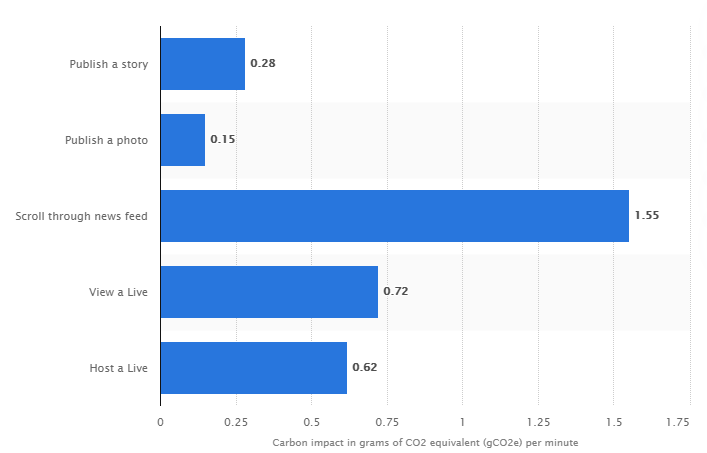
Doesn’t this come as a shock to you? All those times when you were bored and started scrolling through your Instagram feed, you were emitting 1.5g of Carbon. And that is just for one person, imagine the impact all of the internet using population would have on the environment. Here is an estimate of the number of digital users there are on the planet.
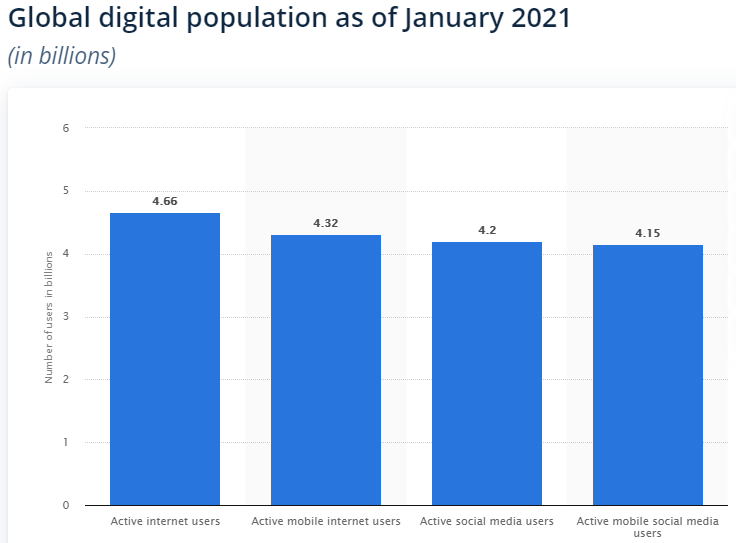
These numbers are exponential and so would the number of websites serving the needs of these people. A website seems like an intangible, virtual platform that shouldn’t pose any harm, but think about it.
You need devices to gain access to the said websites;
You need servers and data centers to make them operational;
And you need further technological devices to keep those servers cool.
These three make the digital world go from intangible to tangible in one quick beat. And taking into account the advancement and growth of technology and the digital world, it’s environmental impact is huge.
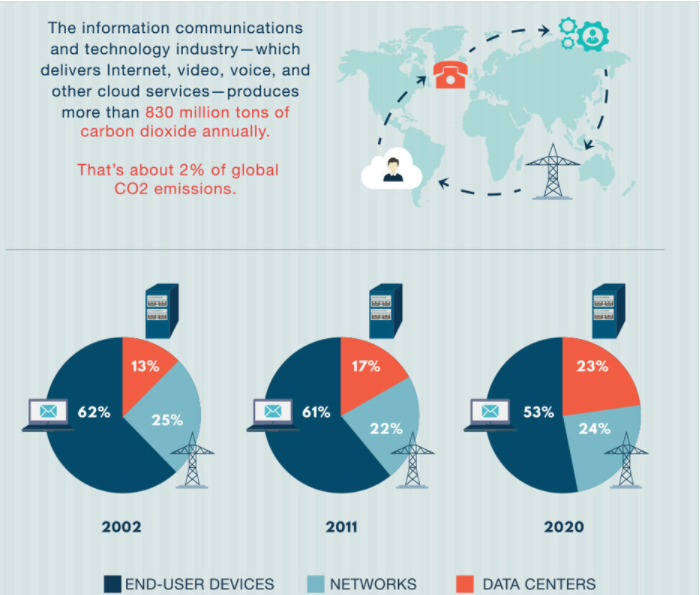
For me, that 2% seemed quite low. I mean two percent can be rounded off as zero, you know and why not focus on the 98% and have better prospects for improvement. And I feel no shame is saying that I was beyond wrong in my perception of the two percent. And here is why.
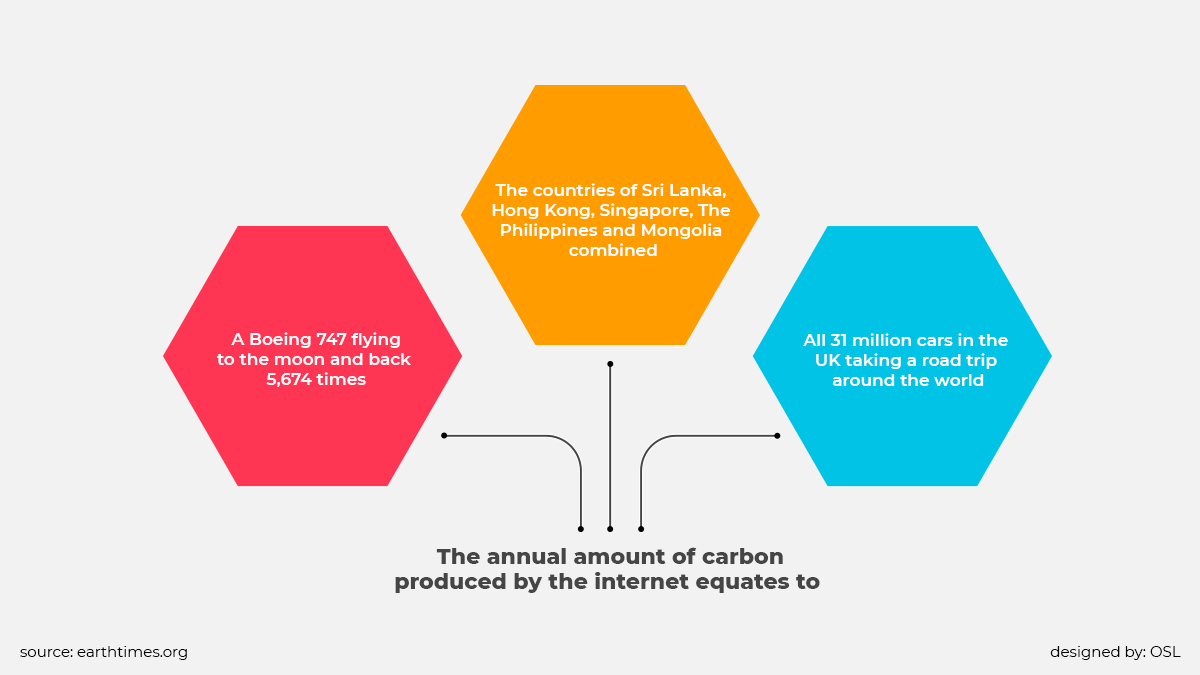
Some even say that the 2% also equates to the entirety of the carbon footprint the aviation industry produces and that’s not something trivial that can be ignored.
The people of today are becoming increasingly aware of the consequences our actions are having on the environment. Yes, many still are oblivious about the internet's contribution in these consequences, but they should be. Like many real-world brands are making a conscious effort of improving their green initiative and thus, improving their brand image by lessening their effect on the planet, the virtual businesses need to do the same, for the planet and for themselves.
And that is why you should be focusing on environmentally friendly websites and experiences that serve your audience and help the planet.
What is the Carbon Footprint of Your Website?
Now you know that your website needs to be as carbon neutral as possible and you’ll have to make certain changes in your design and development process to make that happen. However, there is a big question that needs to be answered before you can take the plunge towards going green.
And that is knowing where you are going wrong, you need to know what your carbon footprint actually is? What are the aspects of your website that needs to be improved or changed altogether to make that happen? And you cannot go about it blindly. I mean you could already have a renewable data center and you might end up switching it for no reason, if you don’t know what you are doing.
If I had to sum up the carbon footprint of websites based on their energy consumption, I’d be left with three areas; the frontend or the design, the network and of course, the servers and the backend data centers.

Apart from these major aspects;
- The traffic levels of your site;
- The time your audience spends on your website;
- The kind of devices your audience uses;
- The kind of power supply available in your audience’s geographical regions;
Also have an impact on your website’s environment impact and you have to be in the loop for all of these.
So, what do you use to work out your carbon footprint?
Well, there are a number of applications that’ll do that job for you. They calculate your CO2 emissions according to different aspects of your websites, from CO2 emissions for each page view to its yearly impact; from pointing out the problems to figuring out the solutions; these applications will make you aware about your website’s part in harming the environment and the things you can do to avoid them.
Website carbon calculator;
The Green Web foundation;
And CO2 Neutral Website;
These are some applications and websites that can help you work out your carbon footprint and get closer to fulfilling the need of green websites. Yes, there is a chance that you might get an exact figure as to your carbon emissions, but the idea of an estimate is enough to make a standing change. This stage is essentially an audit that acts as the prequel to change.
How Can You Go Green and Become Environmentally Friendly?
Like every problem has a solution to counter it, so does your website’s carbon footprint. So, now is the part wherein, you actually make a change, a tangible difference for your intangible online presence.
There are three major ways to go green
Start with a greener server or host
The first step is the one with the biggest impact on the environment and that is your web host providing the servers to make your site work. The amount of energy that these data centers require can probably fuel the aviation industry and no kidding. Therefore, going with a green host is a no brainer.
What is a green host then?
It is a host that puts in the effort to become environmentally friendly by carrying out its hosting activities in a way that doesn’t harm the environment. With close to 8 billion data centers worldwide producing tons and tons of carbon, that becomes more than necessary.
So, how does a server become green?
The most obvious answer to this question is by using renewable energy to power its energy supply. Solar, wind, nuclear or just clean energy would have a drastic effect in making a server greener.
If that isn’t the way to go then offsetting or negating their carbon footprint by investing in renewable energy is an alternative many web hosts have taken up, Green Geeks being one of them, with a carbon offsetting percentage at 300.
Is there any other way to have a green server, say by self dependence?
Yes, there is. And this answer is in cloud servers. They have become quite popular today, both as dedicated and shared servers. It not only helps in reducing costs, but also enhances efficiency in resource usage, with minimal wastage.
The serverless architecture, a category of the cloud servers, allows developers to simply write code and deploy it without worrying about the infrastructure. You can build greener websites using it as it acts as a cloud-agnostic multi language framework. From Google Cloud Platform to AWS and Azure, every major cloud provider is stepping its toes in serverless architecture and its greener implications are the reason.
Go on to build a greener design
From the backend and server rooms, the green initiative moves on to the design and development aspect. And there is a lot to consider here.
Go for cleaner code
The first thing to do on your frontend is make your code cleaner. Writing a script to show you your cumulative CO2, creating a strict standard and making your tracking scripts, analytics, A/B testing adhere to it and focusing on your native functionality instead of adding features on top of them can help you make intelligent choices in your code. If a suitable font, the latest PHP version and a less complicated code can grant you a green credential, why not take it. More on the art of writing clean code here.
Go for reduced files
Smaller files are another way to make your site turn green. I mean, does your site really need a 25MB gif? Would it not be equally utilitarian with compressed images? What’s the worst that can happen if you compress your HTML and JS with a gzip or brotil? Does offloading your giant files on a green third-party provider not sound appealing to you?
Go for optimised server side rendering
Then comes the server side rendering which requires massive proportions of energy and that’s going to be nothing but waste. Why not focus on caching and edge computing, that would not only lessen your server’s round trips, but also provide your user’s a faster experience. Pre-rendered websites are about as green as green can be.
Go for static sites, if possible
Finally on the front end, you can think about switching to static websites, if possible, no compulsion here. Think about a blogging site or a restaurant’s website, do you think it would require the functionality of a global ecommerce site with millions of monthly users? No, it wouldn’t. Since static websites are much more environmentally friendly, if you can make your online presence work with them, opt for them. More on static sites and leveraging static site generators here.
Then make your audience within reach
Your audience and how close you are to them also contributes to your carbon bill. The closer or farther you are to your target consumers drastically affects your carbon footprint, as it would lessen or enhance your network latencies.
To mitigate that, emphasis needs to be given on the use of a CDN that has data centers in the geographical regions your audience is in. It would immensely reduce your carbon footprint. Many major CDN providers have also started focusing on compression algorithms that reduce the payload being transferred on the wire. That should be the goal for achieving green websites.
What more can be done?
Focusing on renewable energy should be one of the primary targets in building and running a green website. Google, for instance, is leading the green initiative for websites all over the world with its data centers producing almost half of the energy than an average data center. Its other renewable energy and carbon offsetting programs accounted for zero operational carbon emissions in 2016.
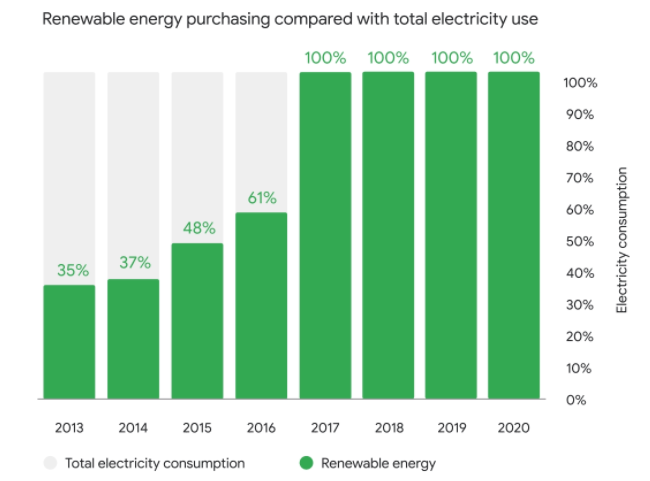
On a smaller level,
- Planting more trees to offset your carbon footprint;
- Educating your users about internet’s harmful effects on the environment;
- And letting go of websites that do not serve a need any longer;
All these can do a lot in the green initiative every one of us needs to embark upon. It’s not just the bigger players who have to put in an effort, even the small static site owner can bring a change, if he is aware and willing.
Can Going Greener Bring You Laurels?
Do you remember the Adidas and Parley association for the Oceans, wherein they came together and designed 7,000 limited edition shoes out of ocean’s plastic trash?
Then there is Apple’s move towards carbon neutrality and releasing its ‘Zero Waste to Landfill’ initiative, making all of its assembly units certified of the same. Do you remember that?
In both of these instances, the brand’s efforts towards going green were highly appreciated. The fact that Adidas sold out its collection almost instantly is proof of that.
So yes, being greener is going to bring you laurels. And you could say that being carbon neutral is often linked to business success. The lesser your CO2 emissions, the higher your chances of growth.
The journey isn’t going to be easy, I'll tell you that. You could have the most eco-friendly host, you could have the most eco-friendly developers and designers, you could have an easy-breezy code, however, an overly optimistic marketer could make all your efforts go down the drain. The simple addition of a chatbot in your JS could make it bulky, and your carbon footprint would start to load up.
Then there is the problem of when eco-friendly developers have to deal with clients who don’t care about their carbon emissions and educating them isn’t an easy road to take.
So, you have to weigh your options and understand that no matter how difficult it would be to make a green effort, the end is always going to be worth it because you’ll be saving your planet with one carbon offset at a time.
To end this blog, here is a video that would enlighten you by summarising everything that we have discussed thus far.
Subscribe
Related Blogs
Trek n Tech Annual Retreat 2025: A 7-Day Workcation of OSL
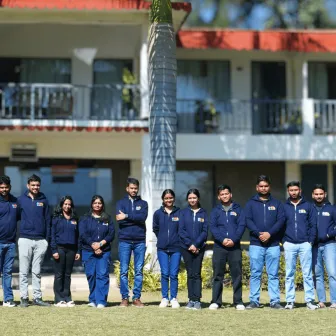
OSL family came together for the Trek n Tech Annual Retreat 2025, a 7-day workcation set amidst the serene beauty of…
Exploring Drupal's Single Directory Components: A Game-Changer for Developers

Web development thrives on efficiency and organisation, and Drupal, our favourite CMS, is here to amp that up with its…
7 Quick Steps to Create API Documentation Using Postman

If you work with API , you are likely already familiar with Postman, the beloved REST Client trusted by countless…




